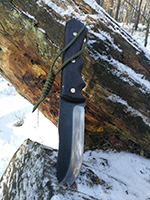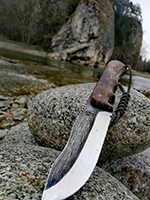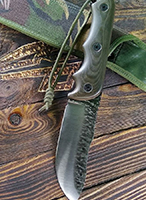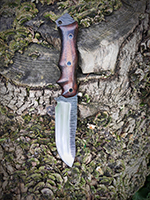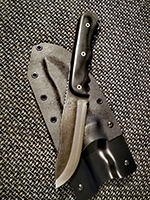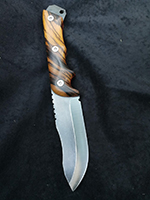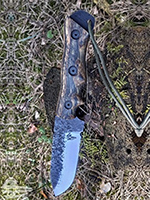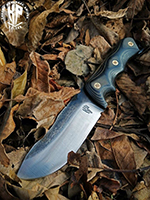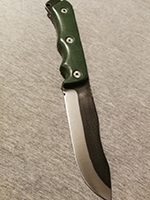BUSHCRAFT - I do this form of recreation very amateurishly, but when making knives I decided to create a BUSHCRAFT or SURVIVAL knife, which has the following features: it is large enough and at the same time handy, you can hold it in your hand and work freely, e.g. on branches, aesthetic values dominated on the side of functionalists and functionality.The blade had to be bent so that the finger does not slip, and at the front of the blade there is a recess in which we can hit, e.g. a thick branch, to make it easier to cut some material. The sharp end at the back is the so-called breaking spike, e.g. glasses. The dimensions of the knife are 29 cm long, 13 cm blade, 4.5 cm high. Steel - the choice is not accidental, it is 50HF (spring) steel, 4 mm thick, which after hardening has a hardness of 55 HRC, is characterized by high impact resistance and can be easily and quickly sharpened in the field - which I consider an advantage. Handle - here I prefer various types of laminates due to the conditions and working environment of the knife (water, moisture), or in more convenient conditions, stabilized wood, twisted or articulated handles.
A bushcraft knife is designed for a wide range of tasks, from preparing meals to building shelters, starting fires, and processing wood. This makes it extremely versatile and useful in many outdoor situations. A solid construction, often with a full tang, ensures strength and stability. A bushcraft knife is designed to withstand harsh conditions and heavy use.
Handles of bushcraft knives are typically designed to be comfortable during prolonged use, minimizing the risk of blisters or hand fatigue. Materials such as Micarta, wood, or G10 provide a secure grip, even in wet conditions. A bushcraft knife has a blade that is hard enough to maintain sharpness for a long time, yet flexible enough to avoid cracks or chips during strikes or cutting through tougher materials.
The blades of bushcraft knives are often made from materials that can be relatively easily sharpened in the field using simple tools, which is crucial in survival situations. Bushcraft knives typically have blades of medium length (about 12-15 cm), which allows for precise tasks as well as more demanding ones, such as batonning wood.
Thanks to their solid construction and ergonomic handle, bushcraft knives are safe to use. Good balance and a secure grip minimize the risk of slipping and accidental cuts. Bushcraft knives often combine modern technology with classic design, making them not only functional but also aesthetically appealing. For many users, they also hold sentimental and cultural value. These features make the bushcraft knife an invaluable tool for any outdoor enthusiast, survivalist, or nature lover.



